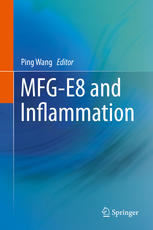MFG-E8 و التهاب ۲۰۱۴
MFG-E8 and Inflammation 2014
دانلود کتاب MFG-E8 و التهاب ۲۰۱۴ (MFG-E8 and Inflammation 2014) با لینک مستقیم و فرمت pdf (پی دی اف)
| نویسنده |
Ping Wang |
|---|
| تعداد صفحهها |
198 |
|---|---|
| نوع فایل |
|
| حجم |
4 Mb |
| سال انتشار |
2014 |
89,000 تومان
معرفی کتاب MFG-E8 و التهاب ۲۰۱۴
پس از کشف فاکتور رشد گلبول چربی شیر 8 (MFG-E8) حدود دو دهه پیش، دوره جدیدی از تعریف نقش بالقوه مفید آن در چندین بیماری التهابی از تحقیقات پایه تا ترجمه در حال ظهور است. در MFG-E8 و Inflammation، ویراستار و همکاران مجموعه ای جذاب گردآوری کرده اند که اکتشافات جدید در زمینه رشد سریع و التهاب MFG-E8 را پوشش می دهد که نه تنها شامل یافته های فرآیندهای لوبول فردی، بلکه از گروهی از محققان برجسته در رشته. MFG-E8 و التهاب با توصیف منشاء، ساختار، بیان، عملکردها و تنظیم MFG-E8 آغاز می شود و سپس به بررسی دقیق پتانسیل آن به عنوان نشانگر سلول های آپوپتوز، تحت فشار و فعال می پردازد. موضوعات مربوط به عملکرد سلولی و فیزیولوژیکی MFG-E8، به ویژه نقش آن در فاگوسیتوز کارآمد سلول های آپوپتوز، عملکرد سد روده، هموستاز سلول های خونی و انعقاد، و در حفظ یک سیستم عروقی سالم است. نقش MFG-E8 در ماکروفاژها، نوتروفیل ها، لنفوسیت ها، سلول های دندریتیک، پلاکت ها و همچنین سلول های خونساز ناکافی در کتاب توضیح داده شده است. فصول همچنین حاوی بسیاری از بحث های روشن درباره اکتشافات اخیر نقش MFG-E8 در بیماری های خودایمنی، سپسیس، ایسکمی بافتی، خونرسانی مجدد، خونریزی، بیماری التهابی روده، آسیب حاد ریه، آسم، فیبروز ریوی، سکته مغزی و پریون است. بیماری آلزایمر با تمرکز بالقوه بر روشن کردن مسیرهای مکانیکی جدید. MFG-E8 and Inflammation یک منبع ضروری برای دانشمندان و محققان بالینی است که بر روی جنبه های اساسی یا کاربردی بیولوژی بیماری MFG-E8 کار می کنند. این کتاب چندین یافته قابل توجه و چشم اندازهای شگفت انگیز آینده را بررسی، تجزیه و تحلیل و مرور می کند که نه تنها پاتوفیزیولوژی بیماری را بازنویسی می کند، بلکه درک ما را در جهت تحقق پتانسیل درمانی جدید در برابر بیماری های التهابی مختلف به روز می کند.



